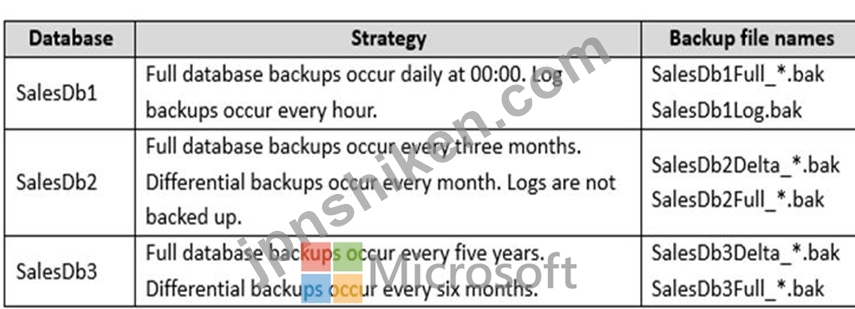有効的な70-764J問題集はJPNTest.com提供され、70-764J試験に合格することに役に立ちます!JPNTest.comは今最新70-764J試験問題集を提供します。JPNTest.com 70-764J試験問題集はもう更新されました。ここで70-764J問題集のテストエンジンを手に入れます。
70-764J問題集最新版のアクセス
「452問、30% ディスカウント、特別な割引コード:JPNshiken」
注:この質問は同じシナリオを使用する一連の質問の一部です。 あなたの便宜のために、シナリオは各質問で繰り返されます。 各質問はそれぞれ異なる目標と答えの選択を提示しますが、シナリオの本文はこのシリーズの各質問でまったく同じです。
次のデータベースSalesDb1、SalesDb2、およびSalesDb3を含むMicrosoft SQL Serverインスタンスを管理します。 各データベースには、ProductsとSalesという名前のテーブルがあります。 次の表は、各データベースの構成を示しています。

各データベースのバックアップ計画を次の表に示します。

フルバックアップ操作または差分バックアップ操作では、それぞれ新しいファイルに書き込み、異なるシーケンス番号を使用します。 次のデータベース破損の問題を観察します。

SalesDb3は、データページの読み取り時に、エラー823および824に関連するいくつかのデータベース破損の問題を報告します。 破損したページに関する次の情報を表示する必要があります。
* データベース名
* 影響を受けるファイルID
* 影響を受けるファイルの物理名
* 影響を受けるページID
* エラータイプを識別するイベントタイプ
* エラー数
ユーザーは、クエリストアを使用してSalesDb2のクエリ統計と実行計画を監視することを計画しています。 監視戦略は次の要件を満たす必要があります。
* クエリストアのディスク使用量が500メガバイト(MB)に達したときに自動データクリーンアップを実行します。
* リソース消費に基づいてクエリをキャプチャします。
* 60日という古いクエリしきい値を使用します。
クエリオプティマイザは、SalesDb2のSalesテーブル上のいくつかのクエリに対する最適でない実行プランを生成します。 テーブルの統計を更新するメンテナンス計画を作成します。 計画は、自動的に作成され、30日間更新されていない統計のみを更新する必要があります。 更新はテーブル内のすべてのデータに基づいている必要があります。
あなたはSalesDb3上の破損したページに関する情報を表示する必要があります。
Transact-SQLステートメントをどのように完成させるべきですか? 回答するには、適切なTransact-SQLセグメントを正しい場所にドラッグします。 各Transact-SQLセグメントは、1回、複数回、またはまったく使用しないことができます。 コンテンツを表示するには、ペイン間の分割バーをドラッグするか、スクロールする必要があります。

次のデータベースSalesDb1、SalesDb2、およびSalesDb3を含むMicrosoft SQL Serverインスタンスを管理します。 各データベースには、ProductsとSalesという名前のテーブルがあります。 次の表は、各データベースの構成を示しています。

各データベースのバックアップ計画を次の表に示します。

フルバックアップ操作または差分バックアップ操作では、それぞれ新しいファイルに書き込み、異なるシーケンス番号を使用します。 次のデータベース破損の問題を観察します。

SalesDb3は、データページの読み取り時に、エラー823および824に関連するいくつかのデータベース破損の問題を報告します。 破損したページに関する次の情報を表示する必要があります。
* データベース名
* 影響を受けるファイルID
* 影響を受けるファイルの物理名
* 影響を受けるページID
* エラータイプを識別するイベントタイプ
* エラー数
ユーザーは、クエリストアを使用してSalesDb2のクエリ統計と実行計画を監視することを計画しています。 監視戦略は次の要件を満たす必要があります。
* クエリストアのディスク使用量が500メガバイト(MB)に達したときに自動データクリーンアップを実行します。
* リソース消費に基づいてクエリをキャプチャします。
* 60日という古いクエリしきい値を使用します。
クエリオプティマイザは、SalesDb2のSalesテーブル上のいくつかのクエリに対する最適でない実行プランを生成します。 テーブルの統計を更新するメンテナンス計画を作成します。 計画は、自動的に作成され、30日間更新されていない統計のみを更新する必要があります。 更新はテーブル内のすべてのデータに基づいている必要があります。
あなたはSalesDb3上の破損したページに関する情報を表示する必要があります。
Transact-SQLステートメントをどのように完成させるべきですか? 回答するには、適切なTransact-SQLセグメントを正しい場所にドラッグします。 各Transact-SQLセグメントは、1回、複数回、またはまったく使用しないことができます。 コンテンツを表示するには、ペイン間の分割バーをドラッグするか、スクロールする必要があります。




